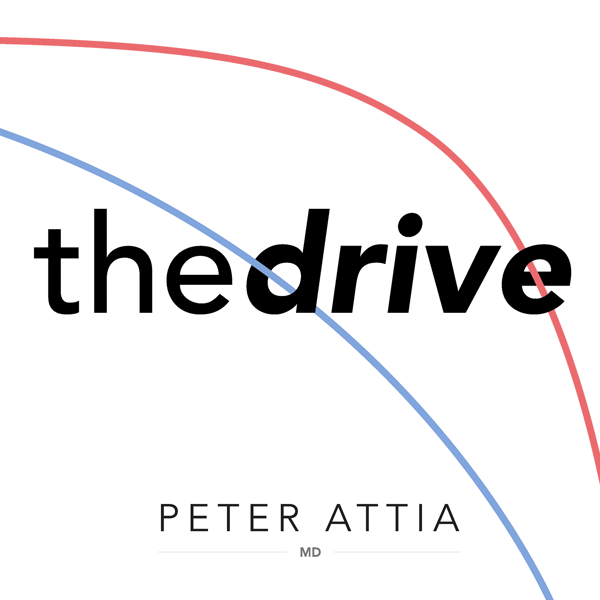#203 - AMA #34: What Causes Heart Disease?
The Peter Attia Drive
Peter Attia, MD
4.7 • 7.3K Ratings
🗓️ 18 April 2022
⏱️ 17 minutes
🧾️ Download transcript
Summary
View the Show Notes Page for This Episode
Become a Member to Receive Exclusive Content
Sign Up to Receive Peter’s Weekly Newsletter
In this “Ask Me Anything” (AMA) episode, Peter dives deep into the topic of atherosclerotic cardiovascular disease (ASCVD)—the number one killer in the developed world. Peter argues for the importance of paying attention to and understanding ASCVD given its ubiquity and inevitability. He goes into great detail about the development of atherosclerosis and how it can take hold at a very early age, the role of cholesterol, and the causal factors of ASCVD that determine prevention strategies. Additionally, he discusses the important metrics and biomarkers found in blood work, as well as diagnostic tests such as coronary artery calcium scores (CAC) and CT angiograms which help to determine the level of arterial damage present. Finally, Peter lays out the keys to understanding and interpreting calcium scores before wrapping up the conversation with his key takeaways regarding prevention.
If you’re not a subscriber and listening on a podcast player, you’ll only be able to hear a preview of the AMA. If you’re a subscriber, you can now listen to this full episode on your private RSS feed or on our website at the AMA #34 show notes page. If you are not a subscriber, you can learn more about the subscriber benefits here.
We discuss:
- The importance of understanding atherosclerosis early in life [2:15];
- Defining atherosclerotic cardiovascular disease (ASCVD), its causes, and the role of cholesterol [9:00];
- The process of developing ASCVD, part 1 [15:00];
- The process of developing ASCVD, part 2 [24:00];
- The process of developing ASCVD, part 3 [32:45];
- How early in life ASCVD can start to develop [40:30];
- Case studies of atherosclerosis and figures showing real pathology [43:00];
- Coronary artery lesions present in autopsies of different age groups [49:15];
- The causal factors of ASCVD that determine prevention strategies [52:15];
- Labs to identify biomarkers of ASCVD ]59:00];
- Diagnostic tests to determine the level of arterial damage present—CAC, CTA, CIMT, and more [1:00:30]
- Keys to understanding and interpreting a CAC score and/or CTA results [1:05:15];
- Is there a risk from cholesterol levels being too low? [1:13:00];
- Key takeaways regarding prevention [1:15:45];
- More.
Connect With Peter on Twitter, Instagram, Facebook and YouTube
Transcript
Click on a timestamp to play from that location
| 0:00.0 | Hey everyone, welcome to a sneak peek, ask me anything, or AMA episode of the Drive Podcast. |
| 0:16.5 | I'm your host, Peter Atia. |
| 0:18.3 | At the end of this short episode, I'll explain how you can access the AMA episodes in full, |
| 0:22.9 | along with a ton of other membership benefits we've created. |
| 0:25.9 | Before you can learn more now by going to peteratia-md.com forward slash subscribe. |
| 0:31.5 | So without further delay, here's today's sneak peek of the Ask Me Anything episode. |
| 0:36.5 | Welcome to Ask Me Anything episode number 34. |
| 0:42.7 | I'm once again joined by Nick Stenson. |
| 0:44.8 | In today's episode, who do a super deep dive answering a lot of questions that have been |
| 0:49.2 | accumulating around atherosclerotic cardiovascular disease? |
| 0:52.7 | Now, atherosclerosis, of course, is the number one killer in the developed world. |
| 0:58.0 | It affects basically everybody. |
| 0:59.6 | So you undoubtedly know somebody who's affected by this, if not you. |
| 1:03.2 | So we thought it was really time to kind of focus deep on this. |
| 1:05.6 | So for this reason, we combined a lot of previous questions that have come in into this episode. |
| 1:09.9 | And so we discussed a lot of things here. |
| 1:11.0 | We discussed why everybody should care about atherosclerosis. |
| 1:13.1 | We talked about exactly what it is and try to explain how it comes about. |
| 1:16.7 | Now it's important to spend a lot of time on this because if you want to understand how |
| 1:20.5 | to prevent it, you really need to understand how it's caused. |
| 1:24.8 | And then that'll give you some sense of what the markers are and what the markers don't |
| 1:30.0 | tell you and what they do tell you. |
... |
Please login to see the full transcript.
Disclaimer: The podcast and artwork embedded on this page are from Peter Attia, MD, and are the property of its owner and not affiliated with or endorsed by Tapesearch.
Generated transcripts are the property of Peter Attia, MD and are distributed freely under the Fair Use doctrine. Transcripts generated by Tapesearch are not guaranteed to be accurate.
Copyright © Tapesearch 2025.

